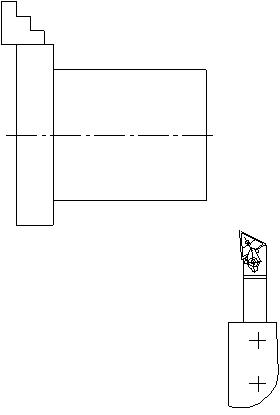Autobiography
Electronic library
Links on a theme
Search report
Individual task
Abstract of master's work on the theme:
"Improving of turning processing due to application of ultrasound"
Introduction
The attempts to use ultrasonic (US) field energy for tooling intensification processes have been since known from the end of 30th in ีี age. The variety of these applications, of a frequency range from an audible threshold to frequencies of a few megahertz and power range from milliwatt to kilowatt with the use of vibration modulation in amplitude, frequency and phase, is the characteristic feature of the modern state of physics and ultrasound technique. The trifle of wave-length is conditioned by radial character of distribution of US waves. Due to it focusing of US waves begins to be widely used by means of acoustic lenses, reflectors and emitters of concave form. This allows to concentrate voice energy, getting in an environment high sound intensity, which we can not get on the surface of traditional emitters of vibrations. Modern focusing systems allow to form characteristics of ultrasonic vibration (USV) orientation and to control them.
From basic effects and ways of the US field energy while tooling we define:
cavitation which is pulsating bubble in mass liquid, filled by steam, gas or their mixture;
soundcapillary effect anomalous deep penetration of liquid in capillaries and narrow cracks under the USV influence;
effect of friction decline and plasticity increase both in parallel and normal orientation of swaying displacements as for bordering surface;
US dispersion of liquid varying from ultrasonic frequency layer of liquid or in US fountain at high-frequencies (kilocycles in a layer, at frequencies of megahertz range in a fountain).
Historical certificate
The first works on the problem of ultrasound were carried out in XIX century. The French scientist F.Savar (1830) tried to set a top limit on frequency of audibility of a persons ear; the English scientist F.Galton (1883), German physicist V.Vin (1903), Russian physicist of P.N.Lebedev and his students, were engaged in the study of ultrasound (1905). A substantial contribution was made by the French physicist P.Lanzheven (1916), who first used piezoelectric properties of quartz to investigate the radiation and receive ultrasound while detecting submarines and depth sea measuring. V. Pierce in the USA (1925) created a device for measuring of ultrasound speed and absorption in gases and liquids (so-called interferometer of Pierce). R.Wood (USA) (1927) records maximum activity of ultrasound in a liquid, an ultrasonic fountain and explored ultrasound influence on living organisms. Soviet scientist R.J.Sokolov in 1928 was the first to detect ultrasonic fault of metal construction and suggested to use an ultrasound for the detection of cracks, shells and other defects in solids.
In 1932 R.Luka and P.Bicar in France, P.Debaj and F.V.Sirs in Germany found out the phenomenon of light diffraction at ultrasonic waves, which was very important while studying liquid and solid structure. Anomalous absorption and dispersion of ultrasound was discovered in polyatomic gases by H.O.Knezer in Germany. This phenomenon was also found in a number of complicated (for example, organic) liquids. Suitable theoretical explanation to these relaxation phenomena was given in a general form by the soviet scientists of L.I.Mandelshtam and A.Leontovich (1937). A relaxation theory was afterwards the basis for molecular acoustics.
In 50 - 60th, different industrial technological applications of ultrasound is becoming widely spread. In development of physical basis of which the large deposit of was done in USSR. D.Rosenberg and his colleagues made a huge contribution. Reaching high activity ultrasound lead to the study of distribution of futures ultrasound powerful waves in gases, liquids, solids; nonlinear acoustics was developed by soviet scientists N.N.Andreev, V.A.Krasilnikov, V.Hohlov and other, and also American and English scientists.
In 70th, Hadson, Mak-Fe and White (USA) (1961), discovered ultrasound strengthening and generation phenomenon in piezometric semi-conductor, acoustoelectronics is being developed.
Physical properties and features of distribution of ultrasound
Ultrasound, resilient vibrations and waves with frequencies approximately from 1,5 2*104 hertz (15 - 20 kHz) and to 109 hertz (1 GHz), ultrasound frequency range from 109 to 1012-13 hertz is assumed to be called hypersound. Ultrasound frequency can be subdivided into three subareas: low frequency ultrasound (1,5*104 - 105 Hz) - LFU, medium frequency ultrasound (105 - 107 Hz) MFU and high-frequency ultrasound (107 - 109 Hz) - HFU. Each of these subareas is characterized by the specific features of generation, reception, distribution and application.
Due to its physical nature an ultrasound can be characterized as resilient waves and it does not differ from a sound. In this way a frequency boundary between voice and ultrasonic waves is therefore relative; it is determined by subjective properties of human ear and corresponds to the averaged high boundary of an audible sound.

Draft turning processing detail - saddle, on cutter with Numerical Program Control (size of animation - 172 kb, consist of 27 slide)
Autobiography
Electronic library
Links on a theme
Search report
Individual task
